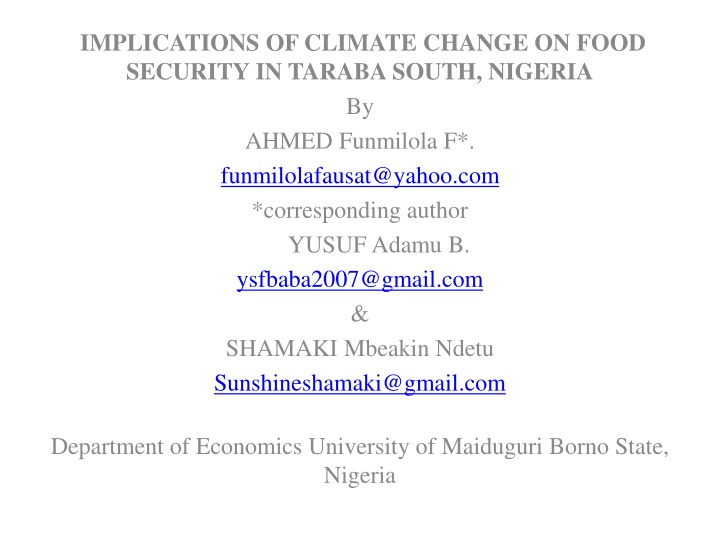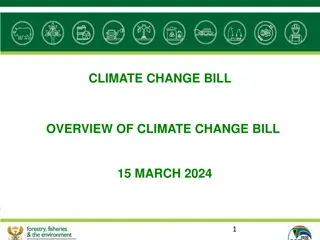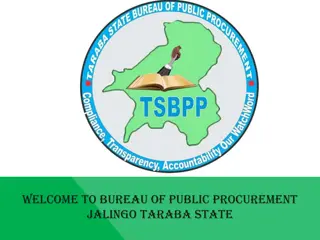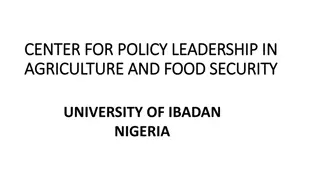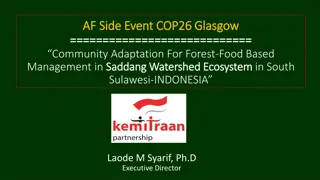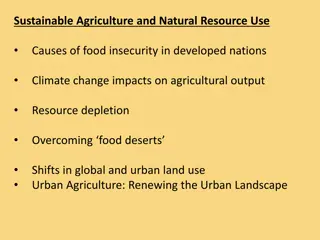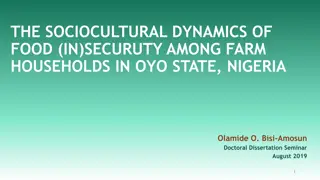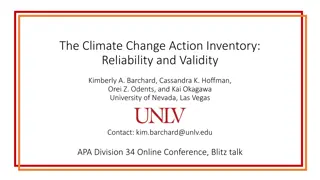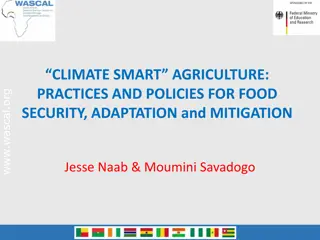Implications of Climate Change on Food Security in Taraba South, Nigeria
Examining the implications of climate change on food security in rural farming households in Southern Taraba State, this study found high levels of food insecurity. Factors such as temperature, rainfall, and household characteristics were analyzed to understand the challenges faced by farming households. Recommendations include focusing on education, income diversification, family planning, and climate change strategies to improve food security.
Download Presentation

Please find below an Image/Link to download the presentation.
The content on the website is provided AS IS for your information and personal use only. It may not be sold, licensed, or shared on other websites without obtaining consent from the author.If you encounter any issues during the download, it is possible that the publisher has removed the file from their server.
You are allowed to download the files provided on this website for personal or commercial use, subject to the condition that they are used lawfully. All files are the property of their respective owners.
The content on the website is provided AS IS for your information and personal use only. It may not be sold, licensed, or shared on other websites without obtaining consent from the author.
E N D
Presentation Transcript
IMPLICATIONS OF CLIMATE CHANGE ON FOOD SECURITY IN TARABA SOUTH, NIGERIA By AHMED Funmilola F*. funmilolafausat@yahoo.com *corresponding author YUSUF Adamu B. ysfbaba2007@gmail.com & SHAMAKI Mbeakin Ndetu Sunshineshamaki@gmail.com Department of Economics University of Maiduguri Borno State, Nigeria
ABSTRACT The study examined the implications of climate change on food security of rural farming households in the Southern part of Taraba State. A multistage random sampling technique was employed to select 160 cassava farming households from four wards spread across two Local Government Areas in the southern part of Taraba State. Descriptive statistics, food security index, Logit regression model and correlation matrics were used to analyze the data. Results of the study showed that majority of the household heads (95.6%) were men, about 56% were within their economic active age of 31-50 years and 34% of the respondents had no education. About 54% of the households had 6 10 members and 63.75% respondents earned monthly income between N50,000 N99,999. The level of food insecurity was high in the study area as only 20.63% of households were food secure. The Logit regression revealed that 12 out of 15 variables included in the model were significant at 1% and 5% in explaining the variation in food security status of households. Temperature and rainfall in the study area from 1983 2012 had an increasing trend at 0.250C and 0.129mm respectively. Temperature and rainfall were positively correlated to cassava yields at 0.56 and 0.65 respectively and both were significant at 1%. Policies for reducing poverty and ensuring food security need to include ensuring improved educational level through adult education and training, exploring income diversification opportunities, increased awareness and access to better family planning facilities and evolving climate change strategies to provide farmers with early warning signals via organized extension service programmes. Keywords: Food Security, Climate Change, Farm Productivity, Implications, Farming Households.
1. INTRODUCTION The idea of food security was presented for the first time in the World Food Conference in 1974. FAO s vision is that of a world without hunger and with most people are able by themselves to obtain the food they need for an active and healthy life. The 1992, International Conference on Nutrition and the 1996 World Submit both emphasized the central need to decrease food insecurity and hunger globally. The modest ambition of the Millennium Development Goals is having the number of people who suffer from hunger between 1990 and 2015 reduced. These ideas, visions, ambitions and goals have not been achieved. Undernourished people in developing regions has remained essentially constant at about 16 per cent since 2000. Climate change and variability is a major threat to food security in many parts of developing regions which are largely dependent on rain fed and labor intensive agricultural production. Climate change in the form of higher temperatures, reduced rainfall and increased rainfall variability, reduces crop yields, reduces net farm revenues and threatens food security in low income based economies includingAfrican countries.
2. OBJECTIVES Examine the socioeconomic characteristics of respondents; Measure the food security status of the respondents; Examine the determinants of food security among farming households; Examine trends of climate variables in the study area; and Estimate the influence of climate factors on farm productivity of the respondents.
3. METHODOLOGY Sampling Procedure Multi-staged sampling technique was employed in this study. Purposive sampling was used in the first stage to select two Local Government Areas (LGAs) that have been affected by draught and or flood from Southern Taraba. In the second stage, two wards were selected from each of the LGAs, while random sampling was used in the third stage to select 40 farming households of predominantly cassava farmers in each ward, making a total of 160 households. Analytical Techniques Descriptive statistics Food security index Correlation matrix Logit Model
4. RESULTS A. B. Socioeconomic Characteristics Food Security Status Classes of Food Consumed ii. Food Security Status Determinants of Food Security Trends of Climate Change Variability (Temperature and Rainfall) Implications of Climate Change i. Temperature and Yield ii. Rainfall and Yield i. C. D. E.
4A. Socioeconomic Characteristics Gender of Household Heads Gender Frequency Percentage Male Female 153 7 95.6 4.4 Age of Household Heads (Years) 21- 30 31 40 41 50 51 60 61 and above 16 61 44 20.0 7 10 38.12 27.50 32 4.4 Educational Level (Years) No education Pri. Sch. (not completed) Pry. School (completed) Sec. School (completed) Post. Secondary 54 5 6 22 51 33.75 3.13 3.75 13.75 31.88
4B. Frequency Distribution of Food Groups consumed by Households Food Groups Consumed by Households Frequency* 160 Food Groups Carbohydrates Percentage 28.2 Proteins Fats and oil Vitamins Minerals 154 78 124 50 27.2 13.8 21.9 8.8
4B. Contd. Food Security Status of Farming Households Food Security Index Frequency Percentage Food secure (0) 33 20.63 Mildly food insecure (-1) 41 25.63 Moderately food insecure (-2) 66 41.25 Severely food insecure (-3) 20 12.5 Total 160 100
4C. Determinants of Food Security Variables Coefficient Std. Err. t-value Table 3: Determinants of Food Security in Taraba South CDR HASZ ASSET COOPMEM FARMEXP PRODENT OFFARM FASZ EXTAG EDU FAYLDS HHINC CREDIT 0.560514 GEND AGE 4.794646 3.241192 -5.978713 -3.730531 1.886648 0 .4118137 7.143052 -1.48449 3.50789 3.012204 4.140923 1.9466 2.553572 1.75927 5.396334 1.549231 2.379394 1.670899 0.9051632 0.1917904 5.457179 2.010267 0.9088587 1.262397 1.845113 0 .6626263 0.6491869 0.8226347 0.0094972 0.89 2.09** -2.51** -2.23** 2.08** 2.15** 1.31 -0.74 3.86*** 2.39** 2.24** 2.94*** 3.93*** 2.14** 5.90***
4D. Trends of Temperature and Rainfall Temperature (0C) 33.67 34.48 32.94 0.42 0.025 Rainfall (mm) 104.7 129.02 47 18.75 0.129 Mean Maximum Value Minimum Value Standard Deviation Coefficient
4D. Contd. 140 35 Mean Annual Rainfall at Ibi Station 120 34.5 y = 0.0254x + 33.273 R = 0.2779 100 Mean Annuan Temperature of Ibi Station 34 80 33.5 y = 0.1294x + 85.448 R = 0.0037 60 33 40 32.5 20 0 32 Year Mean Annual Rainfall at Ibi Station Mean Annuan Temperature of Ibi Station
4E. Implications of Climate Change on Farm Yields Correlation Matrix between Cassava yields, Temperature and Rainfall Yields 1.00 0.5637*** 0.6521 *** Temperature Rainfall Yields Temperature Rainfall 1.0 0.1217 1.00
4E. Contd. Temperature and Yield YEILDS Linear (YEILDS ) 3500.0 3000.0 y = 89.934x R = 0.9005 2500.0 2000.0 1500.0 1000.0 500.0 0.0 30.631.531.330.431.131.031.330.830.530.630.530.631.131.231.031.330.830.730.430.030.730.629.431.129.229.331.430.630.330.7 Mean Maximum Temperature at Taraba State1983-2012
4E. Contd. Rainfall and Yield 3400 3200 y = 112.98x - 361.85 R = 0.8122 3000 2800 2600 2400 2200 2000 1800 1600 1400 1200 1000 800 600 400 200 0 -200 -400 Mean Annual Rainfall at Taraba State 1983-2012 -600
5. CONCLUSION Based on the different food groups consumed by households and the influence of extreme weather conditions such as excessive heat and flooding, only 20.63% of the respondents were food secure. An increase in the variables that significantly determine and are positively related to food security would increase the food security status of the respondents.
6. RECOMMENDATIONS There is need for creating programmes and enactment of policies for reducing poverty and ensuring food security such as National Poverty Eradication Programmes (NAPEP) and Graduate Internship Scheme (GIS) in order to empower the rural households by opportunities thereby improving wage earning capacity. Policies of reducing poverty and ensuring food security need to include climate change strategies. Climate change management authorities such as NIMET should be encouraged to provide farmers with early warning signals via an organized extension service programme. Visit of extension agent has the ability of helping the farming households with better decision making process which will enhance better production. Nutrition oriented programmes should also be implemented to improve on the food substitution capabilities of the households. The fact that farmers are often poor and rarely have access to safe and effective pesticides to combat the menace of climate change, particularly during dry spells, government should assist the farmers with necessary inputs at subsidized rates, robust varieties of plants/seeds and adequate irrigation facilities. exploring income diversification
